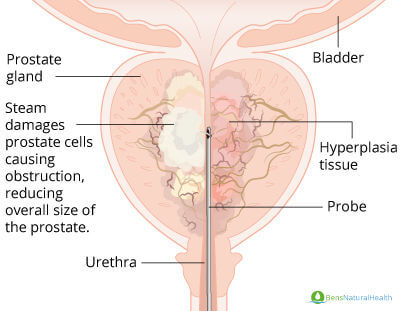Have you noticed that treatment options for enlarged prostate (BPH) are increasing?
One of the latest is called Rezum treatment (pronounced ree-zoom). Rezum treatment uses the heat generated from radiofrequency-generated water vapor to remove excess prostate tissue in order to relieve symptoms.
The urethra—the tube that empties the bladder—passes directly through the walnut-sized prostate gland.
Prostate tissues grow as men age, which enlarges the gland and squeezes the urethra like a belt being gradually tightened around the waist. This makes it increasingly hard to empty the bladder completely at one time. It’s been approved by the US FDA since 2015.
What’s pretty amazing about the Rezum therapy is that it is a simple out-patient therapy that can be done in the office.
No general anesthesia is needed. No medications with unpleasant side effects are required. It’s considered a minimally invasive procedure treatment for BPH (Benign Prostatic Hyperplasia).

What exactly occurs with the Rezum Treatment?
Here’s how it works:
- Rezum therapy can be performed in a clinic or as out-patient therapy.
- Oral pain medications are given one hour before the procedure. Light sedation (local anesthesia) may be offered instead.
- A probe is entered into the urethra to the level of the prostate.
- A few drops of water are added to a handheld device used specifically for this treatment purpose.
- Radiofrequency energy activates the water, which stores the energy.
- The water is heated up to become steam.
- The steamy water vapor is injected into the prostate tissue, especially in the area where the urine flow has been blocked.
- The vapor changes its form back to liquid water. During this time, the energy passes into the cell membrane.
- Six mild warming sensations are felt, and the procedure is over in about 10 minutes.
- Cells that received the energy die.
- A catheter is inserted and will stay in for only a few days. (This depends on the discretion of the doctor).
- The body then absorbs the dead cells, detoxifying the area.
- The enlarged prostate shrinks in time (29% in six months).
What happens to the symptoms of BPH (Benign Prostatic Hyperplasia)?
You’re probably wondering, “Well, what about the BPH symptoms? Do they improve or not?”.
The answer is yes, they do. In fact, in most men, there’s a noticeable improvement in urinary symptoms within two weeks.
Patients report that they won’t get up during the night as much within a very few weeks. Getting up during the night is disruptive for your sleep. And without a good night of sleep, you age faster than ever.
Patients report they’re a lot happier because the nagging urinary tract symptoms (luts) are gone. Full effects are seen within 4-6 weeks.
Your next question may be, “What about urination and sexual intercourse?” Are these disrupted in any way, shape, or form?
The answer is no; they remain intact.
Get Your FREE PSA Lowering Diet Plan!
- Naturally lower PSA levels
- Reduce nighttime trips to the bathroom
- Enjoy better bladder control and urine flow
Side effects of the procedure
There are a few side effects of the procedure:
- Blood in the urine
- Sperm in the urine
- Pain or discomfort
- Increased desire to urinate
These side effects resolve shortly after the procedure.
Your doctor may tell you to continue taking the remainder of your Flomax medication after the procedure, but this depends on your doctor’s recommendation.
Rezum was created because doctors weren’t happy about the other invasive treatment available for the treatment of prostate enlargement.
In contrast with other minimally invasive procedures that use heat transfer, such as transurethral needle ablation or transurethral microwave therapy (TUMT), the mechanism of action for the Rezum system uses the principles of convective heat transfer that exploits the thermodynamic properties of water.
What do the studies say about Rezum?
A UK study published in 2018 reported on a 5-year follow-up of the results of Rezum treatments showed an improvement of symptoms/ symptom relief on the international scale (called the IPSS) from 19.4 to 8.6. This is pretty significant!
Retreatment rates were between 3 and 5%, but no cases of ejaculatory dysfunction were caused by the method. In fact, the scientists reported that the ejaculatory bother to score improved by 31% compared with baseline.
Twenty-seven percent of the patients studied achieved clinically relevant differences in erectile dysfunction in one year.
However, Rezum treatment won’t sample the tissue of the prostate for prostate cancer. The TURP method, on the other hand, finds anywhere from 4.1 to 16.7% of the cases. Thus, Rezum is not particularly suitable for those men who have urinary retention or have a large prostate volume.
How to find a doctor that does Rezum treatment
Since not all patients are chosen for the procedure, it’s best to check with a qualified health practitioner that can discuss the Rezum treatment with you.
Conclusion
The problem with most surgical procedures is that they damage the prostate and therefore cause short or even long-term consequences euphemistically referred to as side effects.
The only difference between them is that they use different technologies. It doesn’t matter how you damage the prostate; it is damage.
Exceptions to this are uro lift since it just relieves pressure on the urethra, but even that is still an invasive procedure.
It seems to me that of all the procedures that cause damage to the prostate rezum causes the least amount of damage. The only truly minimally invasive treatment, which does not damage the prostate is prostate artery embolization.







